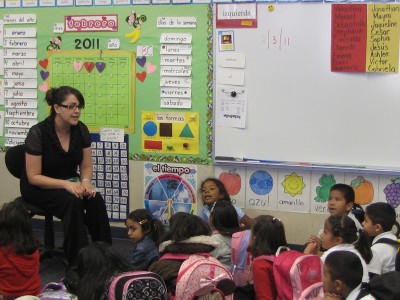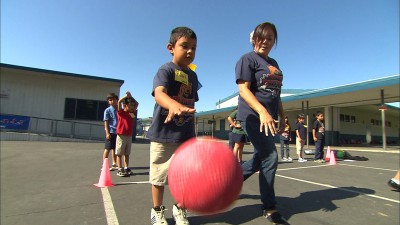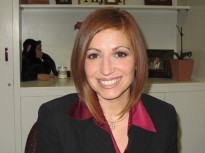Domestic, K-12, Language Learning, Minorities, Public, Required - Written by Wired Academic on Friday, October 5, 2012 6:00 - 0 Comments
Education Nation: Geddes Elementary Shows Benefits Of Dual-Language Education
Kindergarten classes at Ernest R. Geddes Elementary School in Baldwin Park, Calif., are taught primarily in Spanish as part of the school’s bilingual program. (Photo by Sarah Garland)
Students in older grades spend large amounts of class time talking and arguing with one another in small groups. One third-grade teacher, Pamela Ochoa, encourages the children in her group of struggling readers to get out of their chairs and dance. Kindergartners in another room interrupt stories to predict what will happen next and ask about words they don’t understand.
Often at this majority-Hispanic school, the arguments and singing that spill out of classrooms are in a mix of Spanish and English.
“I don’t like quiet classrooms,” says Virginia Castro, the school’s principal. “Learning is noisy.”
During her four-year tenure at Geddes, Castro has led the school from struggling to highly successful. In 2008, fewer than a third of students passed state reading tests. Last year, the percentage passing more than doubled to 62 percent. The gains are even more impressive when compared to students in the rest of the state.
At Geddes, 87 percent of students are poor enough to qualify for federally subsidized lunches. More than half are still learning English. But in 2011, while 56 percent of elementary-age students in California were proficient or above on state tests for English language arts, two thirds of Geddes students were.
In math, 67 percent of California elementary-age students were proficient or above on math tests. In the same year; the figure at Geddes was 74 percent.
Getting children talking to one another is one of the several strategies Castro and her teachers have used to close the achievement gap between their children and those in more affluent schools. The special sauce at Geddes may be its dual-language program. Classes at Geddes are taught in Spanish for 90 percent of the day until third grade, when they transition to more time spent in English.
The research is mixed on whether bilingual programs in general make a difference for student achievement. When bilingual programs were prevalent in California in the 1990s, the gap between English learners and other students was wide. But research has also documented that bilingualism can benefit the brain. And done well, dual-language programs can be a key element in a school’s success, some educators and researchers say.
“It’s just absolutely incontrovertible that teaching children either by building on their primary language to get to English, or by continuing to teach them in their language that they already know while they’re learning English … has better long-term outcomes for the students,” says Patricia Gándara, an education professor at UCLA.
“There’s a lot of research now that shows that dual-immersion programs/bilingual programs are teaching kids to read better,” she added.
One reason the dual-language program works at Geddes is because it’s one part of a strong academic structure, school officials say. Castro is obsessed with data: Teachers give assessments every two weeks in math and reading to see how their students are progressing and where they might need help.
She also gives her teachers lots of time to plan their lessons and work together so they can learn from one another. Once a year, teachers can ask for a “wild-card day,” in which they spend the whole day planning lessons collaboratively while Castro hires substitutes to cover their classes. Classes are also kept relatively small, with an average of fewer than 20 students. California has had a class-size reduction program in grades kindergarten through third grade since 1996; Baldwin Park received $5.3 million from the state in 2008 to reduce the size of 550 elementary classes. But money for the program has since been reduced, and there is a debate about whether class size reduction programs improve student achievement.
And then there is Castro’s strong leadership. “Ms. Castro is obviously awesome and she’s the catalyst,” said Arturo Ortega, an assistant superintendent in the Baldwin Park Unified School District, which encompasses about two dozen schools in a city 20 miles east of downtown Los Angeles. “She’s been able to bring out leadership in her teachers, her staff and her parents.”
Dual-language programs are now relatively rare in California after voters passed Proposition 227, limiting the use of bilingual education, in 1998. Since then, the number of English learners taught in their primary language has dropped by half.
A handful of districts have kept bilingual programs intact, however, including Baldwin Park. Administrators say parents there clamor to enroll their children at Geddes, one of the district’s several rapidly improving schools, in part because of the opportunity for their children to learn in both Spanish and English.
“It’s important for me, because my children are from here. I’m from Mexico, and I want them to know their origins,” said Ana Lepe, speaking in Spanish. The 40-year-old mother of three has sent all of her children to Geddes because she also believes being bilingual will help them get better jobs in the future.
Her youngest child, Cesar, 7, says juggling both languages can be difficult, but, he added, “I feel proud of myself, because I’m learning a lot of things.”
Teachers also see benefits for their students. “When you know two languages, that’s powerful,” said Cara Wilson, a transitional kindergarten teacher.
The program also helps parents, many of them monolingual Spanish speakers, feel more welcome, which in turn helps Castro foster another key element to her success: Dozens of Geddes parents—more than a third of whom never graduated from high school — are now actively involved in their children’s education, helping with homework and volunteering at the school, she says.
“Parents are the core,” Castro said. “They’re the first teachers that a child is going to have.”
THE CHALLENGE
10 percent of public school students are English language learners.
The Challenge: For English Language Learners, mastering the language is even more difficult if they struggle with their first language.
The Solution: At Geddes Elementary School in Baldwin Park, Calif., young students in the dual-language program are taught in Spanish 90% of the day until third grade. This approach has led to significant achievement gains, with 60% of third-graders scoring proficient or above in English language arts in 2011.
(source: NCES: The Condition of Education 2012: Indicator 8-2012)
RESULTS
- Geddes Elementary School’s API score (California’s system for rating schools based on reading and math test scores) rose from 678 to 838 over four years, exceeding the state target of 800. Proficiency on English language arts tests doubled to 62 percent, and the percentage of the school’s students who are proficient in math rose by half, to 74 percent.
- In the 2005-06 school year, 391 students (out of 901) had unexcused absences or were tardy at least three times at Geddes. The truancy rate was 43 percent. In 2010-11, by contrast, 192 students (out of 703) had unexcused absences or were frequently tardy. The truancy rate fell to 27 percent.
- Parental participation went from only a handful of parents regularly visiting the school to between 40 and 50 attending monthly meetings with the principal.
This story was produced by The Hechinger Report, a non-profit journalism organization housed at Columbia University in New York.
Campus Buzz
We welcome Tips & Pitches
Latest WA Original Features
-
“Instreamia” Shakes Loose Moss By Launching Spanish Language Mini-MOOC
-
Jörn Loviscach: A German Math Teaching Sensation Emerges On YouTube & Udacity
-
Open University Enters Battle Of The MOOCs, Launches “FutureLearn”
-
Alvaro Salas As A Case Study In Crowd-Funding An Ivy-League Education
-
Jonathan Mugan: How To Build A Free Computer Within A Computer For Your Child
Paul Glader, Managing Editor
@paulglader
Eleni Glader, Policy Editor
Elbert Chu, Innovation Editor
@elbertchu
Biagio Arobba, Web Developer
@barobba
Contributors:
Michael B. Horn
@michaelbhorn
Derek Reed
@derekreed
Annie Murphy Paul
@AnnieMurphyPaul
Frank Catalano
@FrankCatalano
Ryan Craig
@UniVenturesFund
Jonathan Mugan
@JMugan
Terry Heick
@TeachThought
Alison Anderson
@tedrosececi
Ravi Kumar
@ravinepal

The Pulitzer Prize winning investigation newsroom digs into for-profit education.
-
Most Viewed
- Inside Ashford University: A former staffer talks to WiredAcademic
- Infographic: A History Of Information Organization From Stone-Age To Google
- Davos: 12-Year-Old Pakistani Prodigy Girl Talks About Her Online Learning
- Open University Enters Battle Of The MOOCs, Launches "FutureLearn"
- Pearson Llc + Google Expands LMS Business With "OpenClass" System
-
MARKET INTRADAY SNAPSHOT
- Education & Tech Companies We Follow
| APEI | 40.20 |  -0.17 -0.17 |  -0.42% -0.42% | ||
| APOL | 19.01 |  +0.33 +0.33 |  +1.77% +1.77% | ||
| AAPL | 460.16 |  -6.43 -6.43 |  -1.38% -1.38% | ||
| BPI | 10.74 |  -0.09 -0.09 |  -0.83% -0.83% | ||
| CAST | 0.11 |  +0.01 +0.01 |  +10.00% +10.00% | ||
| CECO | 4.08 |  -0.02 -0.02 |  -0.49% -0.49% | ||
| COCO | 2.40 |  -0.02 -0.02 |  -0.83% -0.83% | ||
| CPLA | 32.03 |  -0.41 -0.41 |  -1.26% -1.26% | ||
| DV | 30.69 |  +0.36 +0.36 |  +1.19% +1.19% | ||
| EDMC | 4.03 |  +0.07 +0.07 |  +1.77% +1.77% | ||
| ESI | 18.34 |  +0.04 +0.04 |  +0.22% +0.22% | ||
| GOOG | 792.89 |  +5.07 +5.07 |  +0.64% +0.64% | ||
| LINC | 6.20 |  +0.06 +0.06 |  +0.98% +0.98% | ||
| LOPE | 25.03 |  +0.36 +0.36 |  +1.46% +1.46% | ||
| PEDH | 0.45 |  0.00 0.00 |  +0.00% +0.00% | ||
| PSO | 18.51 |  -0.27 -0.27 |  -1.44% -1.44% | ||
| SABA | 8.61 |  -0.16 -0.16 |  -1.82% -1.82% | ||
| SCHL | 30.87 |  +0.46 +0.46 |  +1.51% +1.51% | ||
| STRA | 51.95 |  -1.54 -1.54 |  -2.88% -2.88% | ||
| WPO | 414.41 |  +5.35 +5.35 |  +1.31% +1.31% |
Domestic, For-Profit, Gainful Employment, Infographics, Personalized Learning, Private, Public, Required, Universities & Colleges - Jan 31, 2013 6:09 - 0 Comments
Infographic: To Get A Degree Or Not To Get A Degree? Here Is An Answer
More In For-Profit
- Ryan Craig: American Clampdown Forcing Forlorn For-Profit Colleges To Look Abroad
- How For-Profit Colleges Major In Marketing & Fail Education
- Infographic: A Graphical Profile Of Today’s Online College Student
- Infographic: A Comparison Of For-Profits v. Non-Profit Online College Data
- Opinion: How “Shareholder Value” Is Destroying For-Profit, Career Colleges
Cost of Education Domestic Education Quality Ethics For-Profit Friend, Fraud, or Fishy Gainful Employment Graduation Rates Legislation Minorities Opinion Recruitment Regulatory Required Retention Rates Student Loans Universities & Colleges
MOOCs, Required, Technology - Feb 16, 2013 10:04 - 1 Comment
MOOC Monitor: Must Reads This Week
More In Technology
- Infographic: Rise of the MOOCs
- Smart Cities Part II: Why DC Is The Planetary Hub Of Online Learning
- Five Questions: Polling EdTech Startup UnderstoodIt’s Liam Kaufman
- Infographic: The Future of Higher Education
- Anne Collier: Study Shows eBooks Gaining Larger Share & Boosting Overall Reading Habits
Domestic K-12 Parents Reading / Literature Required Technology
Cost of Education, Domestic, Early Childhood Education, Education Quality, Friend, Fraud, or Fishy, Legislation, Minorities, Parents, Public, Required - Feb 18, 2013 4:59 - 0 Comments
Important Early Questions Over Obama’s Early Childhood Program Ambitions
More In Friend, Fraud, or Fishy
- Should For-Profit Companies Manage K-12 Schools? A Skeptical Review
- A Letter To Sen. Tom Harkin About For-Profit Charter Schools
- Ryan Craig: American Clampdown Forcing Forlorn For-Profit Colleges To Look Abroad
- Opinion: The Problem With Deceptive Degree Aggregators In The Search For Online Courses & Degrees
- How For-Profit Colleges Major In Marketing & Fail Education
Domestic Education Quality Ethics For-Profit Friend, Fraud, or Fishy Graduation Rates Minorities Recruitment Required Retention Rates Universities & Colleges





Leave a Reply